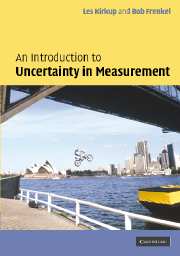 An Introduction to Uncertainty in Measurement
An Introduction to Uncertainty in Measurement Published online by Cambridge University Press: 06 July 2010
Lord Kelvin, a renowned scientist born in Ireland in the nineteenth century, recognised the importance of measurement and spoke about it in passionate terms:
When you can measure what you are speaking about and express it in a number, you know something about it; but when you cannot measure it, when you cannot express it in numbers, your knowledge is of a meagre and unsatisfactory kind; it may be the beginning of knowledge, but you have scarcely in your thoughts advanced to the state of science …
(Lecture given to the Institution of Civil Engineers, 3 May 1883)Measurement is essential to science. Without measurement, scientific models and theories cannot be rigorously tested or challenged. Ambitious scientific and technical endeavours such as the exploration of the surface of Mars, medical diagnosis using magnetic-resonance imaging (MRI) and the evaluation of renewable energy sources would not be possible. Measurement is no less critical in areas such as international trade, with the global economy becoming ever more pervasive.
In this chapter we consider matters key to measurement and the communication of the results of measurement. These include the system of units, scientific notation and significant figures.
The system of units of measurement
To measure the length of a particular object and have the result of that measurement recognised and understood by other people, there must be mutual agreement on a basic unit of length. Over past centuries many units have been adopted as the basis of length measurement in different parts of the world. Some of those units, like the metre, the mile and the fathom, are still in use today.
To save this book to your Kindle, first ensure [email protected] is added to your Approved Personal Document E-mail List under your Personal Document Settings on the Manage Your Content and Devices page of your Amazon account. Then enter the ‘name’ part of your Kindle email address below. Find out more about saving to your Kindle.
Note you can select to save to either the @free.kindle.com or @kindle.com variations. ‘@free.kindle.com’ emails are free but can only be saved to your device when it is connected to wi-fi. ‘@kindle.com’ emails can be delivered even when you are not connected to wi-fi, but note that service fees apply.
Find out more about the Kindle Personal Document Service.
To save content items to your account, please confirm that you agree to abide by our usage policies. If this is the first time you use this feature, you will be asked to authorise Cambridge Core to connect with your account. Find out more about saving content to Dropbox.
To save content items to your account, please confirm that you agree to abide by our usage policies. If this is the first time you use this feature, you will be asked to authorise Cambridge Core to connect with your account. Find out more about saving content to Google Drive.